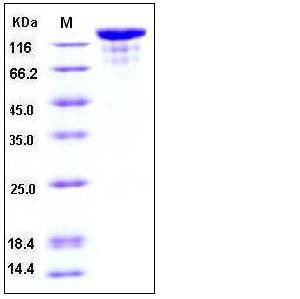Human VEGFR3 / FLT4 Protein (Fc Tag)
FLT-4,FLT-41,FLT41,LMPH1A,PCL,VEGFR-3,VEGFR3
- 100ug (NPP1618) Please inquiry
| Catalog Number | P10806-H02H |
|---|---|
| Organism Species | Human |
| Host | Human Cells |
| Synonyms | FLT-4,FLT-41,FLT41,LMPH1A,PCL,VEGFR-3,VEGFR3 |
| Molecular Weight | The recombinant human VEGFR3/Fc is a disulfide-linked homodimeric protein. The reduced monomer consists of 990 amino acids and predicts a molecular mass of 111 kDa. As a result of glycosylation and proteolytic cleavage, rhVEGFR3/Fc migrates as three bands (160, 85, 75 kDa) corresponding to the full length and the cleaved two polypeptides respectively in SDS-PAGE under reducing conditions. |
| predicted N | Tyr 25 & Ser 473 |
| SDS-PAGE |  |
| Purity | > 97 % as determined by SDS-PAGE |
| Protein Construction | A DNA sequence encoding the extracellular domain (Met 1-Ile 776) of human VEGFR3 (NP_002011.2) was expressed with the fused Fc region of human IgG1 at the C-terminus. |
| Bio-activity | Measured by its binding ability in a functional ELISA . 1. Immobilized recombinant human VEGFR3 at 5 μg/ml (100 μl/well) can bind recombinant human VEGF-D at a linear range of 62.5-2000 ng/ml. 2. Immobilized recombinant human VEGF-C at 10 μg/ml (100 μl/well) can bind recombinant human VEGFR3 at a linear range of 0.64-80 ng/ml. 3. Scatchard analysis showed the affinity constant (Kd) of recombinant human VEGF-C bound to recombinant human VEGFR3 was 1.4 nM. |
| Research Area | Cancer |Signal transduction |Protein Kinase |Receptor Tyrosine Kinase (RTK) |
| Formulation | Lyophilized from sterile PBS, pH 7.4 1. Normally 5 % - 8 % trehalose and mannitol are added as protectants before lyophilization. Specific concentrations are included in the hardcopy of COA. |
| Background | Vascular endothelial growth factor receptor 3 (VEGFR3), also known as FLT-4, together with the other two members VEGFR1 (FLT-1) and VEGFR2 (KDR/Flk-1) are receptors for vascular endothelial growth factors (VEGF) and belong to the class III subfamily of receptor tyrosine kinases (RTKs). The VEGFR3 protein is expressed mainly on lymphatic vessels but it is also up-regulated in tumor angiogenesis. Mutations in VEGFR3 have been identified in patients with primary lymphoedema. The VEGF-C/VEGF-D/VEGFR3 signaling pathway may provide a target for antilymphangiogenic therapy in prostate cancer, breast cancer, gastric cancer, lung cancer, non-small cell lung cancer (NSCLC), and so on. |
| Reference |
